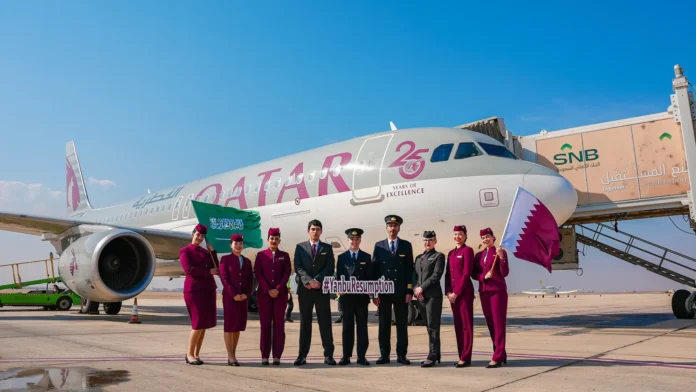MUMBAI- Saudia Airlines (SV) beats Qatar Airways (QR) to become the second largest airline in the Middle East region regarding available seats in August 2024.
The Middle East aviation sector continues to show robust growth and fierce competition among major carriers.

Saudia Beats Qatar Airways
According to data from OAG’s Schedules Analyser for August 2024, Emirates (EK) remains the dominant player in the region, offering 3,262,223 seats. This underscores Dubai’s position as a global hub for international air travel.
Following closely behind are Qatar Airways and Saudi Arabian Airlines (Saudia), with 2,853,214 and 2,880,943 seats respectively. This trio of carriers forms the backbone of Middle Eastern aviation, connecting the region to global destinations and supporting their home countries’ growing tourism and business sectors.
Notably, while not in the top three by capacity, Etihad Airways (EY) is experiencing the fastest growth rate among Middle Eastern carriers. With a 30% year-on-year increase, equating to an additional 254,000 seats, Etihad is aggressively expanding its market share.
The low-cost carrier segment is also showing significant strength. Flynas (XY) and Flyadeal (F3), both based in Saudi Arabia, are recording impressive growth rates of 17% and 12% respectively. This trend reflects the increasing demand for budget travel options within the region and to international destinations.
Other key players in the market include:
- FLYNAS: 1,200,999 seats
- Flydubai: 1,277,388 seats
- Air Arabia: 882,287 seats
- Oman Air: 467,921 seats
- Gulf Air: 521,079 seats
The data also highlights the growing importance of Saudi Arabia in the regional aviation landscape.
With Saudia leading in volume increases (291,000 additional seats, up 11% from last August) and strong performances from Flynas and Flydeal, the Kingdom is investing heavily in its aviation sector to support its ambitious tourism and economic diversification goals.
Airline Capacity in the Middle East
The most striking development is the substantial surge in domestic capacity. August 2024 sees 4,623,089 domestic seats available, marking a remarkable 16.4% increase from the 3,972,689 seats in August 2023. This growth of approximately 650,000 seats underscores the strengthening of internal markets within Middle Eastern countries.
International capacity, while growing more modestly, still shows positive momentum. The number of international seats has risen from 19,344,804 in August 2023 to 19,871,469 in August 2024, representing a 2.7% increase. This addition of 527,000 seats reflects the region’s continued importance as a global aviation hub.
Mainline vs Low-Cost Carrier (LCC) Dynamics
The low-cost carrier segment continues to gain traction in the Middle Eastern market. LCC capacity has grown from 6,800,849 seats in August 2023 to 7,114,773 seats in August 2024, an increase of nearly 314,000 seats. This growth has led to LCCs increasing their market share from 28% to 29% of total capacity.
Mainline carriers have also expanded their offerings, with capacity rising from 16,516,644 seats in August 2023 to 17,379,785 seats in August 2024. This growth of about 863,000 seats demonstrates that traditional carriers are also capitalizing on the region’s aviation boom.
What are your thoughts on the Middle Eastern market? Let us know in the comment section.
Join us on Telegram Group for the Latest Aviation Updates. Subsequently, follow us on Google News.
The post Saudia Beats Qatar Airways in Number of Seats in Middle East appeared first on Aviation A2Z.
